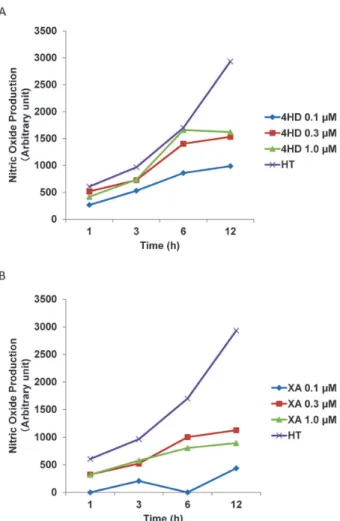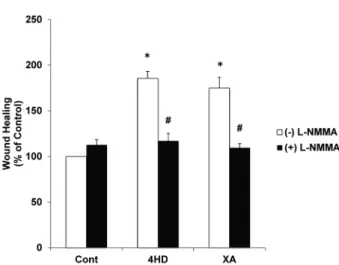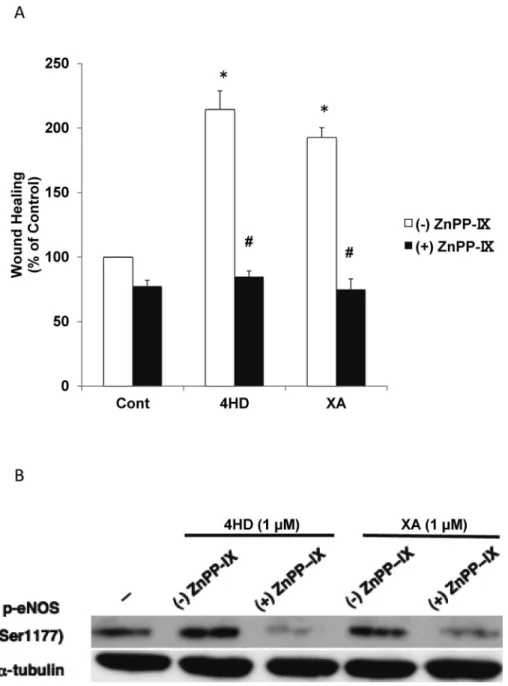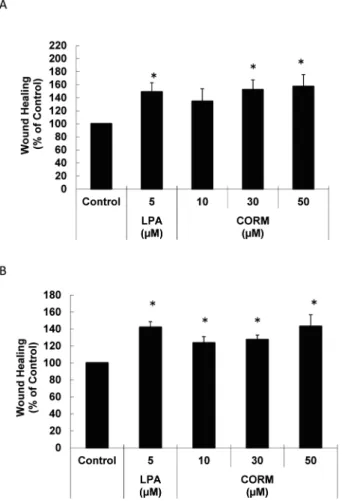Pr om
ot i on of Endot hel i al W
ound H
eal i ng by t he
Chal c ones 4- hydr oxyder r i c i n and Xant hoangel ol ,
and t he M
ol ec ul ar M
ec hani s m
of Thi s Ef f ec t
著者
H
I SATO
M
E Takum
ar u, W
ACH
I Yos hi t aka, YAM
AM
O
TO
Yur i , EBI H
ARA Aoi , I SH
I YAM
A Ayane, M
I YAZAKI
H
i t os hi
j our nal or
publ i c at i on t i t l e
J our nal of D
evel opm
ent s i n Sus t ai nabl e
Agr i c ul t ur e
vol um
e
12
num
ber
1
page r ange
25- 33
year
2017- 05- 26
U
RL
ht t p: / / hdl . handl e. net / 2241/ 00150270
Promotion of Endothelial Wound Healing by the Chalcones
4-hydroxyderricin and Xanthoangelol, and the
Molecular Mechanism of This Effect
Takumaru Hisatome
1, Yoshitaka Wachi
2, Yuri Yamamoto
1,
Aoi Ebihara
1, Ayane Ishiyama
1and Hitoshi Miyazaki
1, 3*
1
Graduate School of Life and Environmental Sciences, University of Tsukuba, Tennodai 1-1-1, Tsukuba, Ibaraki 305-8572, Japan
2Nougakuken Center, Ichige 1087-1, Hitachinaka, Ibaraki 312-0033, Japan 3
Faculty of Life and Environmental Sciences, University of Tsukuba, Tennodai 1-1-1, Tsukuba, Ibaraki 305-8572, Japan
The two chalcones xanthoangelol (XA) and 4-hydroxyderricin (4HD) are major functional polyphenolic com-pounds in the edible herbAngelica keiskei, which is native to Japan. The compounds XA and 4HD are known to have anti-inflammatory and anti-diabetic functions although their beneficial effect on vascular disease is not clear. Athero-sclerosis induced by lifestyle-related diseases such as obesity and hypertension is a serious vascular disease in which endothelial injury plays a major pathogenic role. Therefore, the healing of endothelial injury is considered important in preventing atherosclerosis. The present study examined whether XA and 4HD promote the wound healing of cultured porcine vascular endothelial cells (ECs) and analyzed the molecular mechanisms of their effect. Both com-pounds promoted endothelial wound healing, induced nitric oxide (NO) production, and increased heme oxygenase-1 (HO-1) expression as well as the phosphorylation level of endothelial NO synthase (eNOS). The wound healing promoted by these compounds was inhibited by pretreatment with the NOS inhibitor L-NMMA and HO-1 inhibitor ZnPPIX, respectively. ZnPPIX inhibited the phosphorylation of eNOS as well. XA- and 4HD-dependent wound healing was also blocked by hemoglobin, a carbon monoxide (CO) absorbent. A CO-releasing molecule facilitated the wound healing, which was suppressed by pretreatment with L-NMMA. These results suggest that XA and 4HD stimu-late wound healing by increasing HO-1 expression with subsequent CO production, which activates eNOS followed by NO generation. Our findings indicate that the two chalcones inAngelica keiskeimay have a preventative effect against atherosclerosis.
Key words:Angelica keiskei, anti-oxidation, chalcones, endothelial cells, wound healing
───────────────────────
Introduction
The two chalcones xanthoangelol (XA) and 4-hydroxyderricin (4HD) are major functional polyphe-nolic compounds in the edible herb Angelica keiskei, which is native to Japan. These two compounds are known to have various beneficial effects. They exhibit
antihypertensive, anticancer, and diuretic effects (Enokiet al., 2007; Kimura and Baba, 2003; Kimura, 2005; Motaniet al., 2008). The compounds also have a suppressive effect on blood glucose level (Shimizuet al., 1999; Matsuura et al., 2001), an antiulcer effect and an inhibitory effect on gastric secretion (Murakami et al., 1990), a beneficial effect on lipid metabolism
Received: November 1, 2016, Accepted: February 14, 2017
* Corresponding author: Faculty of Life and Environmental Sciences, University of Tsukuba, Tennodai 1-1-1, Tsukuba, Ibaraki 305-8572, Japan.
(Ogawa et al., 2007), and an antibacterial effect (Inamori et al., 1991). However, their effect on pre-venting atherosclerosis is not clear. Accumulating evi-dence demonstrates that other polyphenolic com-pounds, such as resveratrol in red wine and epigal-locatechin gallate in green tea, are effective in pre-venting atherosclerosis (Iijima et al., 2000; Iijima et al., 2002; Miura et al., 2001; Lorenz et al., 2004). Especially, resveratrol is believed to play a role in the unexpectedly low rates of heart disease and associated mortality in France, where a typical diet including dairy product and meat has a high fat content. Res-veratrol has a number of beneficial effects, including protection of the endothelium from oxidized low-density lipoprotein (Ou et al., 2006), and anticancer and neuroprotective effects (Brisdelli et al., 2009). Epigallocatechin gallate was demonstrated to promote nitric oxide (NO) generation followed by vasodilation (Lorenzet al., 2004) and to prevent atherosclerosis in a mouse model (Miura et al., 2001).
Heart disease and cerebrovascular disease are major causes of death and account for approximately 25% of mortality in Japan. These diseases are caused by ath-erosclerosis, which is induced by lifestyle-related dis-ease called metabolic syndrome such as obesity, dia-betes, and hypertension. Metabolic syndrome is linked to the increase in reactive oxygen species (ROS) levels, which lead to endothelial injury. Monocytes and T-lymphocytes adhere to the injuries, eventually creating atheromas which result in vascular occlusion. Endothelial cells (ECs) adjacent to the wound repair the wounded area through the migration and/or pro-liferation of these cells. Since the delay in wound healing causes thrombus formation and vascular hyper-permeability leading to atherosclerosis, endothelial wound repair is a fundamental step in the prevention of atherosclerosis.
A number of endogenous molecules are involved in endothelial wound healing. NO generated by endothe-lial NO synthase (eNOS) acts as an endothelium-derived relaxing factor. NO also contributes to the proliferation and migration of ECs, and elicits cyto-protective and atherocyto-protective effects in the vas-culature (Cooke, 2003; Gewaltig, 2002; Kibbe et al., 1999). Kuhlencordt et al. (2001) demonstrated that endothelial NO suppresses atherosclerosis and that atherosclerosis progresses rapidly in eNOS-knockout mice. Thus, regulating NO production is considered pivotal for endothelial wound healing. Heme
oxy-genase-1 (HO-1) is an enzyme that catabolizes heme and biliverdin into carbon monoxide (CO) and free iron. CO generated by HO-1 was indicated to phos-phorylate eNOS and prevent hypertension via NO production (Wegiel et al., 2010; Zuckerbraun et al., 2006; Rodellaet al., 2008).
In the present study, we aimed to evaluate the effect of XA and 4HD on endothelial wound healing, and to investigate the molecular mechanism of this effect, focusing on NO, eNOS, and HO-1.
Materials and Methods
1. Materials
Mixture of chalcones was perchased from Japan Bio Science Laboratory CO.,Ltd. and XA and 4HD were purified from the mixture in our laboratory. Hydroxy-tyrosol (HT) was purchased from Cayman Chemical Co. (Ann Arbor, MI, USA). Lysophospatidic acid (LPA), Carbon monoxide-releasing molecules (CORM), NG-methyl-L-arginine acetate salt (L-NMMA) and hemoglobin were purchased from Sigma-Aldrich (Missouri, USA). Zinc (II) Protoporphyrin IX (ZnPPIX) was perchased from Merck Millipore (Darmstadt, Germany).
2. Cell culture
ECs were isolated from porcine pulmonary arteries and grown in Dulbecco's modified Eagle’s medium (DMEM) at 37℃ in a humidified 5% CO2incubator.
The DMEM containing low glucose was supplemented with 10% fetal bovine serum (FBS), 100 U/ml peni-cillin, and 100μg/ml streptomycin. ECs were ana-lyzed between passages six to ten.
3. Wound-healing assay
ECs were seeded onto 3.5-cm plates at a density of 3×105cells/plate and incubated for 7 h with DMEM containing 10% FBS. Cell culture medium was then replaced with DMEM containing 1% FBS and the ECs were incubated for another 16 h. Then the ECs were treated with test substances (4HD, XA, and CORM) and positive control (LPA). In wound-healing assays with inhibitors, L-NMMA, ZnPPIX or hemoglobin was applied 1 h before the addition of test substances and positive control. A wound was then created by scratching the monolayer of confluent, serum-starved ECs with a 200-μl pipette tip. The scratch area was imaged using an inverted microscope attached to a digital camera (Leica DM IBRE) immediately (0 h) and at 8 and 24 h after wound creation. The plate was incubated at 37℃from wound creation to the 8- and
J. Dev. Sus. Agr. 12 (1)
24-h. Three microscopic fields were selected at ran-dom from the microscopic images at each time, and the number of cells in the fields was counted. Wound healing (%) was calculated as the value for each test substance or positive control versus the control valued at each time.
4. NO production assay
NO production was measured by fluorometric detection using DAF-2 DA, a cell-permeable and NO-sensitive fluorescent dye. ECs were seeded onto a 96-well plate (at 6×103cells/well) and incubated with 10
μM DAF-2 DA in a dark condition for 45 min at 37℃. After washing the ECs with Hank’s balanced salt solution (HBSS), NO production was stimulated by the
addition of HBSS containing 4HD, XA or HT. Fluo-rescence intensities were measured using a spectro-fluorophotometer (Powerscan HT, Dainippon Pharma-ceutical, Tokyo, Japan) at excitation and emission wavelengths of 485 and 535 nm, respectively, after 1, 3, 6, and 12 h of treatment.
5. Western blot analysis
ECs were seeded onto 3.5-cm plates at a density of 2×105cells/plate, and incubated for 7 h with DMEM containing 10% FBS. Cell culture medium was then replaced with DMEM containing 1% FBS and the cells were incubated for 16 h. After required treatment, ECs were washed twice with ice-cold PBS and suspended in a lysis buffer containing 50% glycerol, 100 mM NaF, 10 mM sodium pyrophosphate, 1% Triton X-100, 1 mM Na3 VO4, 1 mM phenylmethylsulfonyl fluoride (PMSF), 10μg/mL antipain, 10μg/mL leu-peptin, and 10μg/mL aprotinin. Lysates were sepa-rated by centrifugation at 17,900 g for 15 min at 4℃
and used for the experiment. Equal amounts of pro-teins per sample were separated by 10% sodium do-decyl sulfate polyacrylamide gel electrophoresis and transferred to polyvinylidene difluoride membranes. Membranes were then blocked with 5% non-fat dried milk or 5% BSA/TBS-T at room temperature and sub-sequently incubated overnight with antibodies at 4℃.
Thereafter, blots were incubated with secondary antibodies at room temperature. Bands were detected using a Western LightningTMChemiluminescence Kit (Life Technologies Corporation, Santa Cruz, CA, USA) in accordance with the manufacturer's instructions. The intensity of each band was quantified using a LAS-4000 imaging mini analyzer (Fujifilm, Tokyo, Japan).
6. Statistical analysis
Data are expressed as mean values (±S.D.) for at
least three independent experiments. Differences be-tween treatments were analyzed using Student’ s t-test. P values less than 0.05 were considered statisti-cally significant.
Results
1. 4HD and XA promote endothelial wound healing. We evaluated the effect of 4HD and XA on endothelial wound healing at 8 and 24 h after wound creation. The wound healing at both 8 h and 24 h was maximally promoted by 4HD and XA at a concentration of 1μM (Fig. 1). 4HD tended to be more effective than XA in repairing the wound.
2. 4HD and XA increase endothelial NO production. We evaluated the effect of 4HD and XA on endo-thelial NO production to investigate the mechanism for their promotion of wound healing. 4HD and XA
time-dependently increased endothelial NO production at all tested concentrations (0.1, 0.3, and 1.0μM) respective-ly, except for 0.1μM XA (Fig. 2). The NO production level of 4HD tended to be more effective than XA. We used 4HD and XA at 1μM for subsequent experi-ments, because the highest NO production was ob-tained at 1μM.
3. 4HD and XA activates eNOS.
We evaluated the phosphorylation level of eNOS in 4HD- and XA-treated ECs to investigate whether the two chalcones activate eNOS. We targeted phos-phorylation of eNOS at serine 1177 (Ser1177) because Ser1177 is one of the activation sites (Kukreja and Xi, 2007; Mount et al., 2007) and phosphorylated by various kinases including Akt, protein kinase A, and AMP-activated kinase (Fulton et al., 1999). Phos-phorylated eNOS (Ser1177) level increased time-dependently from 3 h after addition of 4HD and from 6 h after addition of XA (Fig. 3). This effect of pro-longed chalcone treatment on eNOS activation is consistent with the result of NO production shown in Fig. 2, suggesting that 4HD- and XA-induced NO pro-duction is linked to eNOS activation.
4. NO mediates 4HD- and XA-stimulated endothelial wound healing.
We investigated the effect of the NO inhibitor L-NMMA on 4HD- and XA-dependent wound healing. Pretreatment of ECs with 1 mM L-NMMA suppressed the wound healing promoted by 4HD and XA (Fig. 4), indicating that NO production mediates chalcone-enhanced endothelial wound healing.
5. 4HD and XA increase endothelial HO-1 protein expression.
We investigated HO-1 protein expression levels in 4HD- and XA-treated ECs to evaluate the role of HO-1 in chalcone-enhanced endothelial wound healing. HO-1 protein expression level increased
time-depend-J. Dev. Sus. Agr. 12 (1)
28
Fig. 3. 4HD and XA activate eNOS. Phosphorylated eNOS (p-eNOS) (Ser1177) levels in ECs were de-termined by western blotting after treatment with 4HD or XA for 0, 3, 6, 12, and 24 h. α-Tubulin was used as the internal standard.
ently from 3 h after addition of 4HD and from 6 h after addition of XA (Fig. 5), suggesting that HO-1 is likely to be involved in the promotion of wound healing by these chalcones.
6. HO-1 is involved in 4HD- and XA-dependent endo-thelial wound healing and eNOS phosphorylation.
We examined the effect of the HO-1 inhibitor ZnPPIX on 4HD- and XA-induced wound healing. Pretreatment of ECs with ZnPPIX inhibited wound healing (Fig. 6A). We also evaluated phosphorylated eNOS levels in 4HD- and XA-treated ECs after pret-reatment with ZnPPIX. The inhibitor suppressed chalcone-induced eNOS phosphorylation (Fig. 6B). These data suggest that HO-1 is critically implicated in 4HD- and XA-stimulated endothelial wound healing by activating eNOS.
7. HO-1-dependent generation of CO activates eNOS. We investigated the effect of CORM, a CO-releas-ing molecule, on wound healCO-releas-ing to know whether HO-1-induced generation of CO plays an important role in wound healing. CORM promoted wound healing in a dose-dependent manner at 8 and 24 h after wound crea-tion (Fig. 7). The eNOS inhibitor L-NMMA suppres-sed CORM-dependent wound healing (Fig. 8). hemo-globin (Hb), a CO absorbent, inhibited 4HD- and XA-related wound healing (Fig. 9). These data suggest that HO-1-dependent production of CO critically con-tributes to the wound healing induced by these chal-cones through eNOS activation.
Discussion
In the present study, we investigated the effect of the chalcones 4HD and XA on endothelial wound healing. We found that both chalcones promote the wound healing of cultured ECs by increasing the expression of HO-1, which generates CO followed by the activation of eNOS with subsequent NO production.
The dysfunction of ECs induced by various stresses including oxidative stress is critically implicated in the initiation and progression of atherosclerosis. There-fore, the compounds that promote endothelial wound healing are strong candidates for anti-atherogenic factors. We have already found more than ten such candidates. They include resveratrol and its dimer ε -viniferin in red wine (Zghonda et al., 2011), HT in olive oil (Zrelli et al., 2011), carnosic acid in rose-mary, and caffeoylquinic acid and chlorogenic acid in coffee. All of them are polyphenolic compounds and generate NO by activating eNOS, which is consistent with the present data of the chalcones. Interestingly, resveratrol,ε-viniferin, HT, carnosic acid raised HO-1 expression as 4HD and XA whereas caffeoylquinic acid and chlorogenic acid did not, suggesting that eNOS activation mechanism may be different,
de-Fig. 5. 4HD and XA increase endothelial HO-1 protein expression. HO-1 expression levels in ECs were determined by western blotting analysis after treatment with 4HD or XA for 0, 3, 6, 12, and 24 h.
α-Tubulin was used as the internal standard. Fig. 4. NO mediates 4HD- and XA-promoted endo-thelial wound healing. Wound healing was deter-mined 8 h after wound creation for LPA, 4HD, and XA-treated cells with and without pretreatment with 1 mM L-NMMA. * p<0.05 vs. Cont (−);#p<0.05 vs.
pending on the polyphenolic compound (data not shown).
Our data demonstrate that 4HD- and XA-dependent increase in HO-1 expression and phosphorylation level of eNOS with subsequent NO production is sustained. In contrast, although acetylcholine induces vasore-laxation by activating eNOS followed by NO
pro-duction via the PI3 kinase/Akt signaling pathway, this effect is short-lived (Zecchin et al., 2007; Seto et al., 2010). We consider that natural polyphenolic com-pounds including 4HD and XA obtained from normal dietary may be more effective in sustaining endothelial wound healing and NO generation than endogenous substances such as acetylcholine. In agreement with
J. Dev. Sus. Agr. 12 (1)
30
our thought, there are many reports indicating that natural polyphenolic compounds including 4HD and XA reduce blood pressure (Ogawa et al., 2005; Zghondaet al., 20112).
Conclusions
We investigated two chalcones, 4HD and XA, for their potential to promote wound healing. These chal-cones are present in the edible herb Angelica keiskei. The prevention of various diseases through diet has received much attention recently. Prompt healing of endothelial injury is important for the prevention of atherosclerosis. 4HD and XA are known to have some beneficial health effects, but their efficacy against atherosclerosis is still unclear. Therefore, the present study aimed to elucidate the effects of 4HD and XA on
in vitroendothelial wound healing and understand the molecular mechanism of their effects.
We found that the chalcones 4HD and XA promote wound healing by increasing HO-1 expression with subsequent CO production, which activates eNOS fol-lowed by NO generation. Our findings suggest that these two chalcones in Angelica keiskei may have a preventative effect against atherosclerosis.
Fig. 7. CORM promotes endothelial wound healing. Wound healing was determined 8 h (A) and 24 h (B) after wound creation for LPA- and CORM-treated cells. LPA was used as a positive control. * p<0.05 vs. Cont.
Fig. 8. L-NMMA suppresses CORM-dependent wound healing. Wound healing was determined 8 h after wound creation for CORM (50μM)-treated ECs with and without pretreatment with 1 mM L-NMMA. * p< 0.05 vs. Cont(−),#p<0.05 vs CORM(−).
References
Brisdelli F, D’Andrea G, Bozzi A, 2009. Resveratrol: a natural polyphenol with multiple chemopreventive properties. Curr Drug Metab. 10, 530-546.
Cooke JP., 2003. NO and angiogenesis. Atheroscler Suppl. 4, 53-60.
Enoki T, Ohnogi H, Nagamine K, Kudo Y, Sugiyama K, Tanabe M, Kobayashi E, Sagawa H, Kato I, 2007. Antidiabetic activities of chalcones isolated from a Japanese Herb, Angelica keiskei. J Agric Food Chem. 6013-6017.
Fulton D, Gratton JP, McCabe TJ, Fontana J, Fujio Y, Walsh K, Franke TF, Papapetropoulos A, Sessa WC, 1999. Regula-tion of endothelium-derived nitric oxide producRegula-tion by the protein kinase Akt. Nature. 399, 597-601.
Gewaltig MT, Kojda G, 2002. Vasoprotection by nitric oxide: mechanisms and therapeutic potential. Cardiovasc Res. 55, 250-260.
Iijima K, Yoshizumi M, Hashimoto M, Kim S, Eto M, Ako J, Liang YQ, Sudoh N, Hosoda K, Nakahara K, Toba K, Ouchi Y, 2000. Red wine polyphenols inhibit proliferation of vascular smooth muscle cells and downregulate ex-pression of cyclin A gene. Circulation. 101, 805-811.
Iijima K, Yoshizumi M, Hashimoto M, Akishita M, Kozaki K, Ako J, Watanabe T, Ohike Y, Son B, Yu J, Nakahara K, Ouchi Y, 2002. Red wine polyphenols inhibit vascular smooth muscle cell migration through two distinct sig-naling pathways. Circulation. 105, 2404-2410.
Inamori Y, Baba K, Tsujibo H, Taniguchi M, Nakata K, Kozawa M, 1991. Antibacterial activity of two chalcones, xanthoangelol and 4-hydroxyderricin, isolated from the root of Angelica keiskei KOIDZUMI. Chem Pharm Bull. 39, 1604-5.
Kibbe M, Billiar T, Tzeng E, 1999. Inducible nitric oxide syn-thase and vascular injury. Cardiovasc Res. 43, 650-657.
Kimura Y, Baba K, 2003. Antitumor and antimetastatic acti-vities of Angelica keiskei roots, part 1: Isolation of an ac-tive substance, xanthoangelol. Int J Cancer. 106, 429-437.
Kimura Y, 2005. New anticancer agents: in vitro and in vivo evaluation of the antitumor and antimetastatic actions of various compounds isolated from medicinal plants.: In Vivo. 19, 37-60.
Kuhlencordt PJ, Gyurko R, Han F, Scherrer-Crosbie M, Aretz TH, Hajjar R, Picard MH, Huang PL, 2001. Accelerated atherosclerosis, aortic aneurysm formation, and ischemic heart disease in apolipoprotein E/endothelial nitric oxide synthase double-knockout mice. Circulation. 104, 448
-454.
Kukreja RC, Xi L, 2007. eNOS phosphorylation: a pivotal molecular switch in vasodilation and cardioprotection? J Mol Cell Cardiol. 42, 280-2.
Lorenz M, Wessler S, Follmann E, Michaelis W, Düsterhöft T, Baumann G, Stangl K, Stangl V, 2004. A constituent of green tea, epigallocatechin-3-gallate, activates endothelial nitric oxide synthase by a phosphatidylinositol-3-OH-kinase-, cAMP-dependent protein phosphatidylinositol-3-OH-kinase-, and Akt-de-pendent pathway and leads to endothelial-deAkt-de-pendent vaso-relaxation. J Biol Chem. 279, 6190-6195.
Matsuura M, Kimura Y, Nakata K, Baba K, Okuda H, 2001.
Artery relaxation by chalcones isolated from the roots of Angelica keiskei. Planta Med. 67, 230-235.
Miura Y, Chiba T, Tomita I, Koizumi H, Miura S, Umegaki K, Hara Y, Ikeda M, Tomita T, 2001. Tea catechins prevent the development of atherosclerosis in apoprotein E-de-ficient mice. J Nutr. 131, 27-32.
Motani K, Tabata K, Kimura Y, Okano S, Shibata Y, Abiko Y, Nagai H, Akihisa T, Suzuki T, 2008. Proteomic analysis of apoptosis induced by xanthoangelol, a major constituent of Angelica keiskei, in neuroblastoma. Biol Pharm Bull. 31, 618-626.
Mount PF, Kemp BE, Power DA, 2007. Regulation of endo-thelial and myocardial NO synthesis by multi-site eNOS phosphorylation. J Mol Cell Cardiol. 42, 271-279.
Murakami S, Kijima H, Isobe Y, Muramatsu M, Aihara H, Otomo S, Baba K, Kozawa M, 1990. Inhibition of gastric H+, K(+)-ATPase by chalcone derivatives, xanthoangelol
and 4-hydroxyderricin, from Angelica keiskei Koidzumi. J Pharm Pharmacol. 42, 723-726.
Ogawa H, Ohno M, Baba K, 2005. Hypotensive and lipid reg-ulatory actions of 4-hydroxyderricin, a chalcone from An-gelica keiskei, in stroke-prone spontaneously hypertensive rats. Clin Exp Pharmacol Physiol. 32, 19-23.
Ogawa H, Okada Y, Kamisako T, Baba K, 2007. Beneficial effect of xanthoangelol, a chalcone compound from An-gelica keiskei, on lipid metabolism in stroke-prone spon-taneously hypertensive rats. : Clin Exp Pharmacol Physiol. 34, 238-243.
Ou HC, Chou FP, Sheen HM, Lin TM, Yang CH, Huey-Herng Sheu W, 2006. Resveratrol, a polyphenolic compound in red wine, protects against oxidized LDL-induced cyto-toxicity in endothelial cells. Clin Chim Acta. 364, 196
-204.
Rodella LF, Vanella L, Peterson SJ, Drummond G, Rezzani R, Falck JR, Abraham NG, 2008. Heme oxygenase-derived carbon monoxide restores vascular function in type 1 dia-betes. Drug Metab Lett. 2, 290-300.
Seto SW, Lam TY, Or PM, Lee WY, Au AL, Poon CC, Li RW, Chan SW, Yeung JH, Leung GP, Lee SM, Ngai SM, Kwan YW, 2010. Folic acid consumption reduces resistin level and restores blunted acetylcholine-induced aortic relaxa-tion in obese/diabetic mice. J Nutr Biochem. 21, 872-880.
Shimizu E, Hayashi A, Takahashi R, Aoyagi Y, Murakami T, Kimoto K, 1999. Effects of angiotensin I-converting en-zyme inhibitor from Ashitaba on blood pressure of spon-taneously hypertensive rats. J Nutr Sci Vitaminol. 45, 375-383.
Wegiel B, Gallo DJ, Raman KG, Karlsson JM, Ozanich B, Chin BY, Tzeng E, Ahmad S, Ahmed A, Baty CJ, Otterbein LE, 2010. Nitric oxide-dependent bone marrow progenitor mo-bilization by carbon monoxide enhances endothelial repair after vascular injury. Circulation. 121, 537-548.
Zecchin HG, Priviero FB, Souza CT, Zecchin KG, Prada PO, Carvalheira JB, Velloso LA, Antunes E, Saad MJ, 2007. Defective insulin and acetylcholine induction of endo-thelial cell-nitric oxide synthase through insulin receptor substrate/Akt signaling pathway in aorta of obese rats. Diabetes. 56, 1014-1024.
Zghonda N, Yoshida S, Araki M, Kusunoki M, Mliki A,
J. Dev. Sus. Agr. 12 (1)
Ghorbel A, Miyazaki H, 2011. Greater effectiveness ofε
-Viniferin in red wine than its monomer resveratrol for inhibiting vascular smooth muscle cell proliferation and migration. Biosci. Biotechnol. Biochem. 75, 1259-1267. Zghonda N, Yoshida S, Araki M, Kusunoki M., Mliki, A,
Ghorbel, A, Miyazaki, H, 2012.ε-Viniferin is more
effec-tive than its monomer resveratrol in improving the func-tions of vascular endothelial cells and the heart. Biosci. Biotechnol. Biochem. 76, 954-960.
Zrelli H1, Matsuoka M, Kitazaki S, Zarrouk M, Miyazaki H, 2011. Hydroxytyrosol reduces intracellular reactive oxy-gen species levels in vascular endothelial cells by upregu-lating catalase expression through the AMPK‒FOXO3a pathway. Eur J Pharmacol. 660, 275-282




